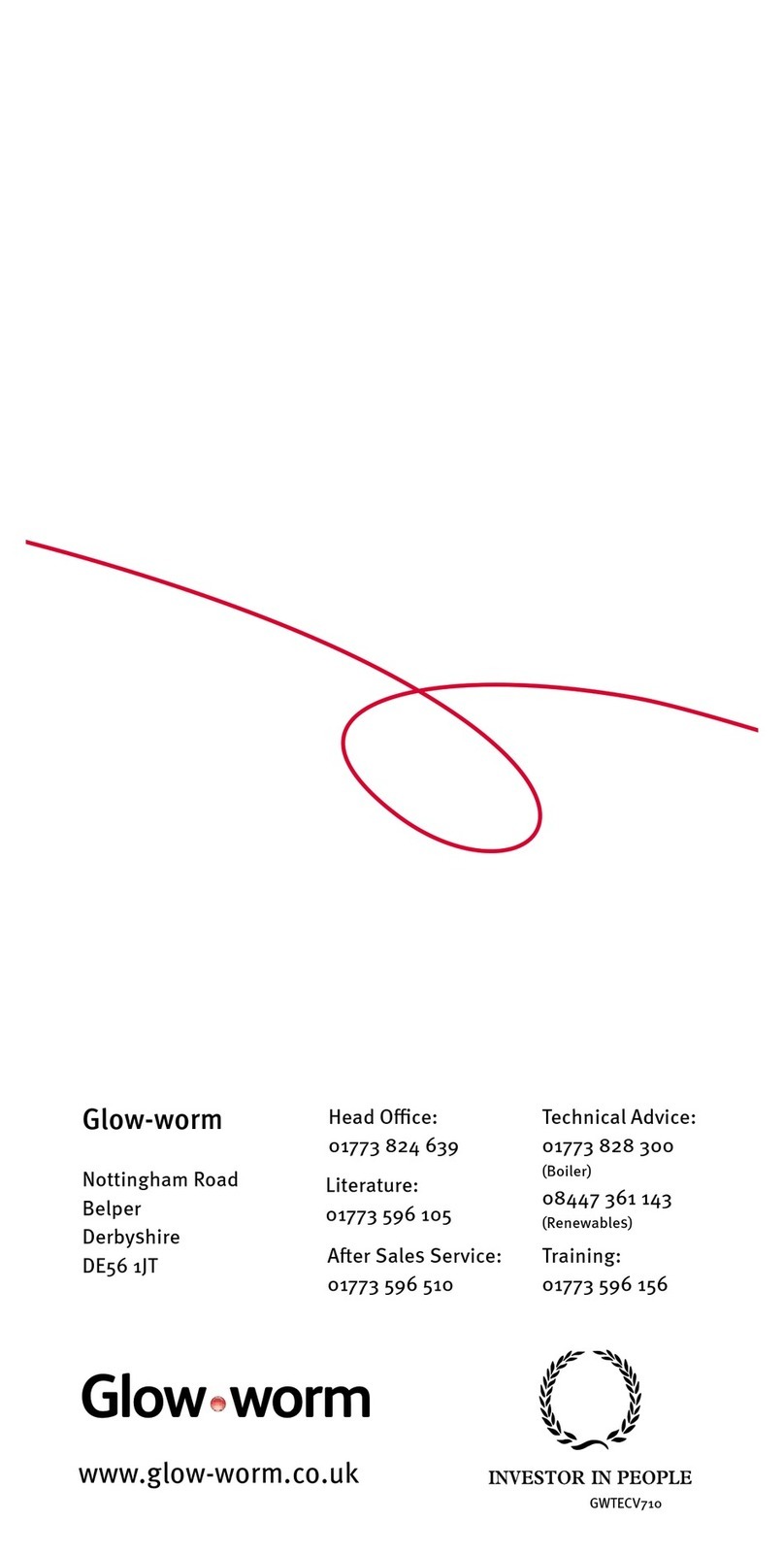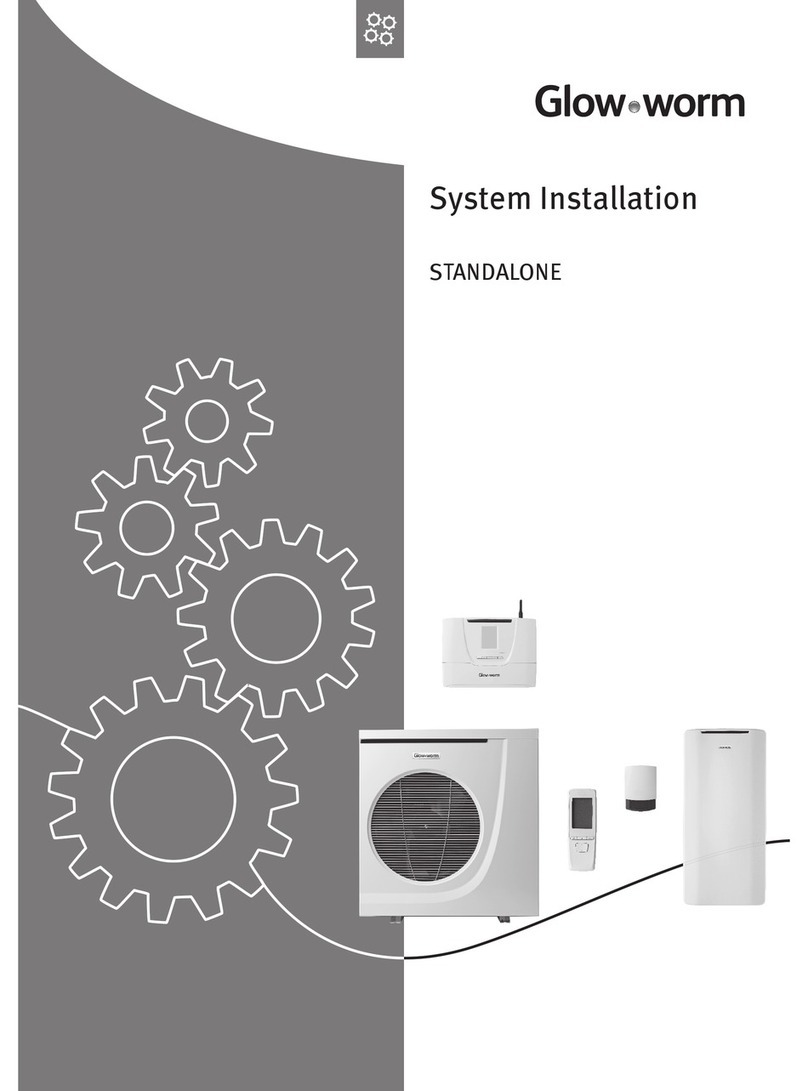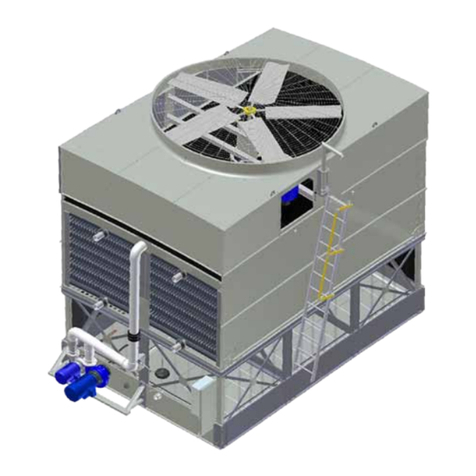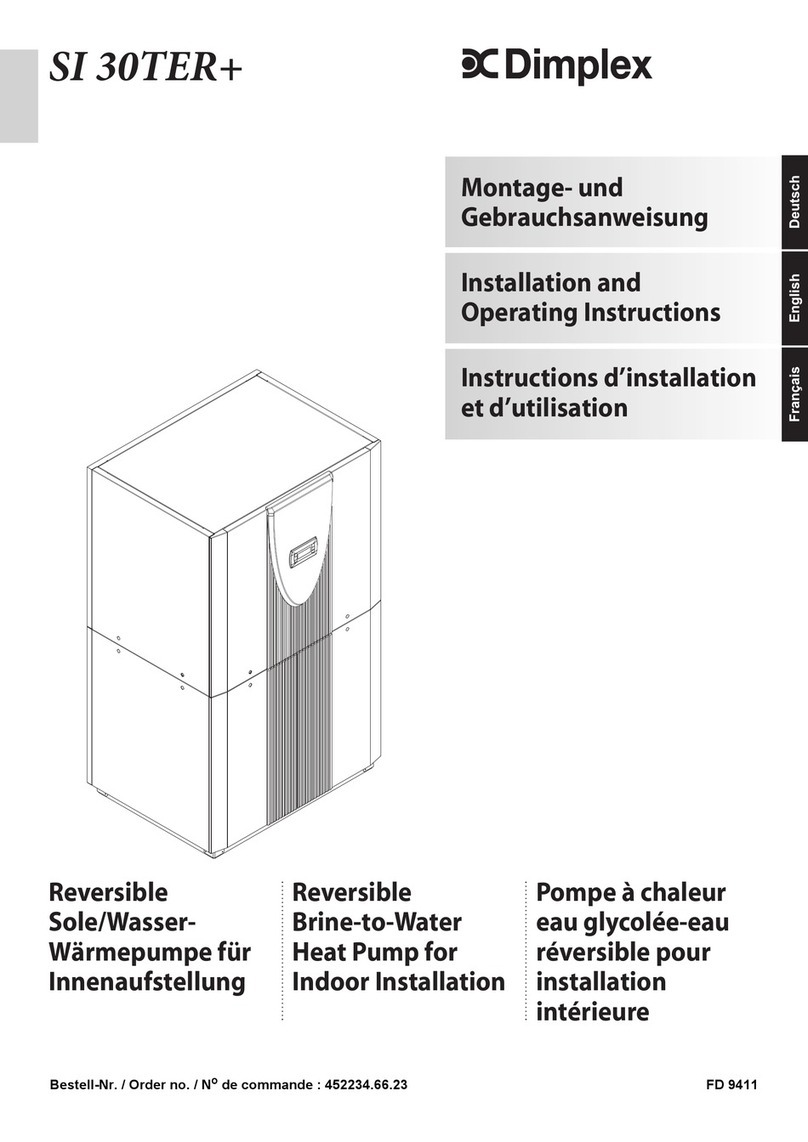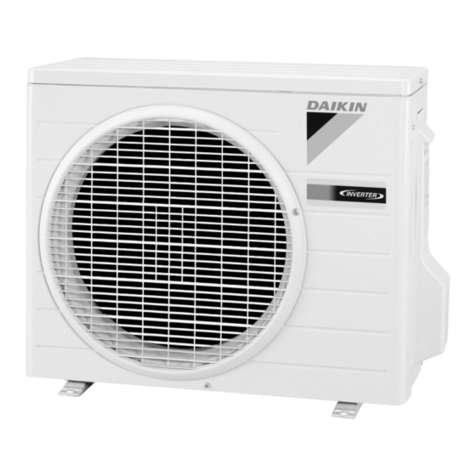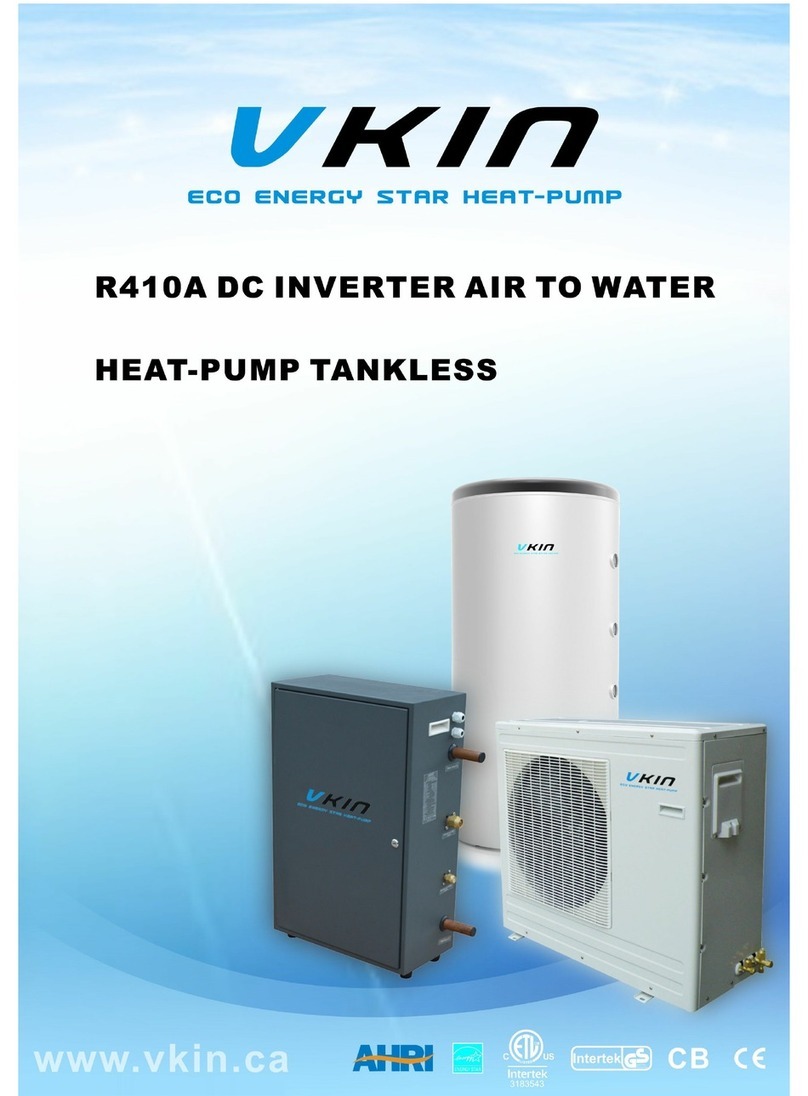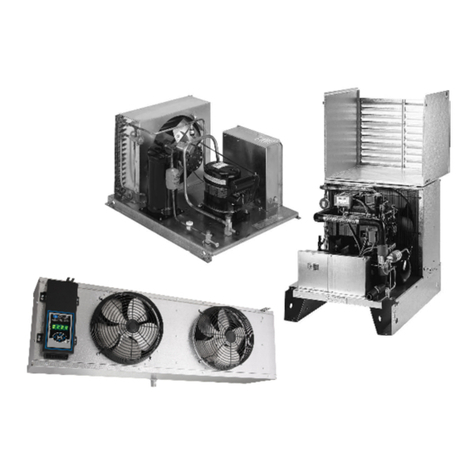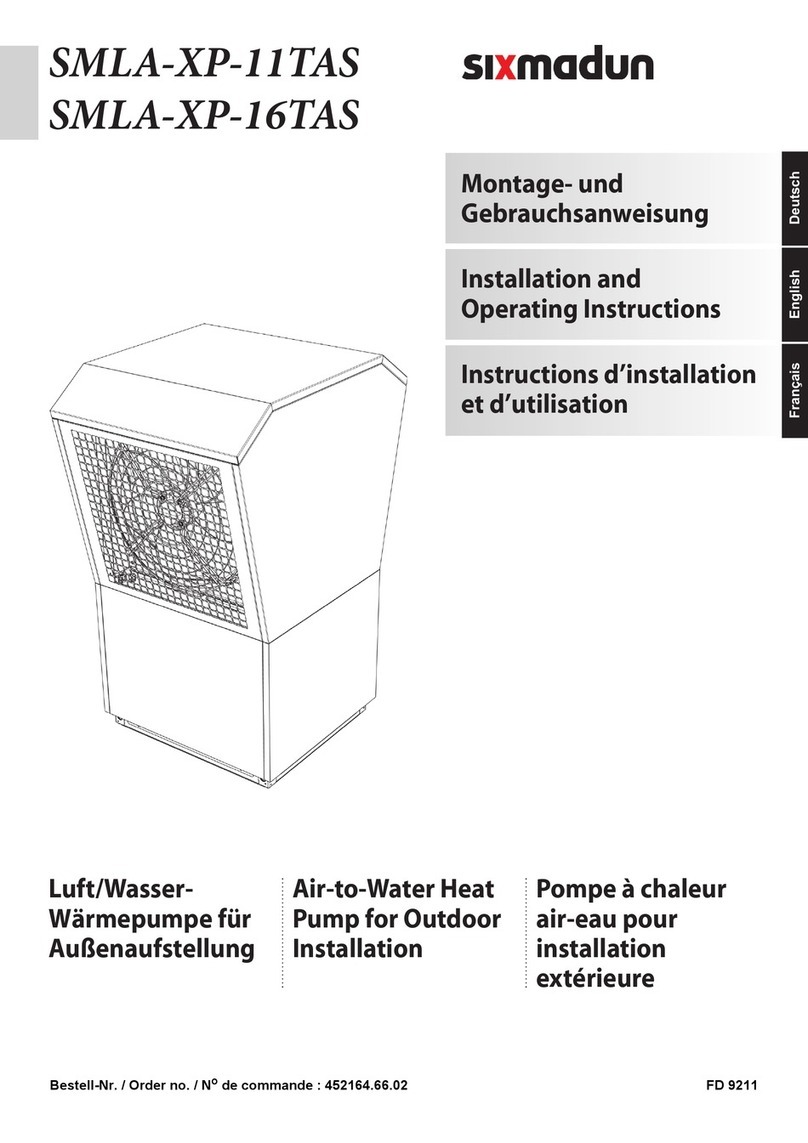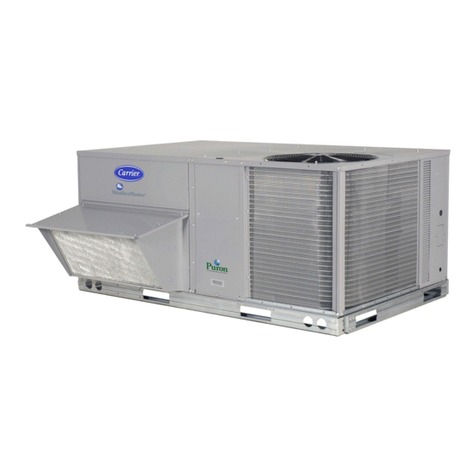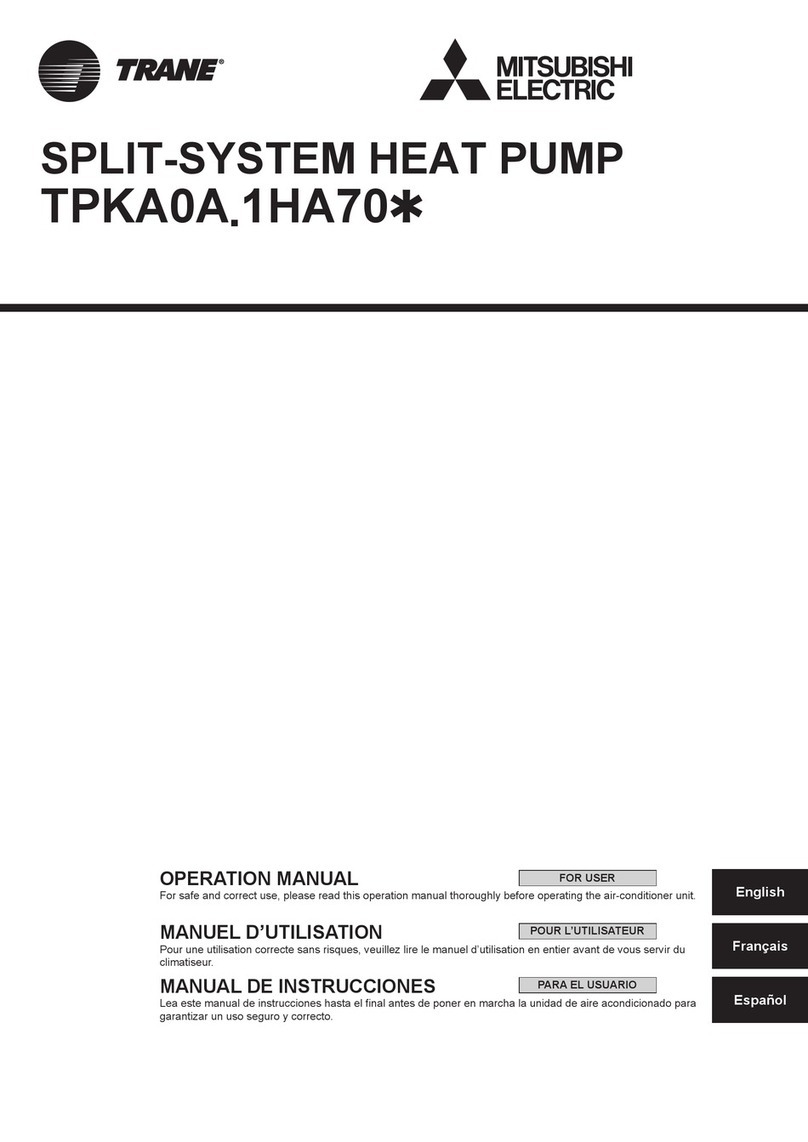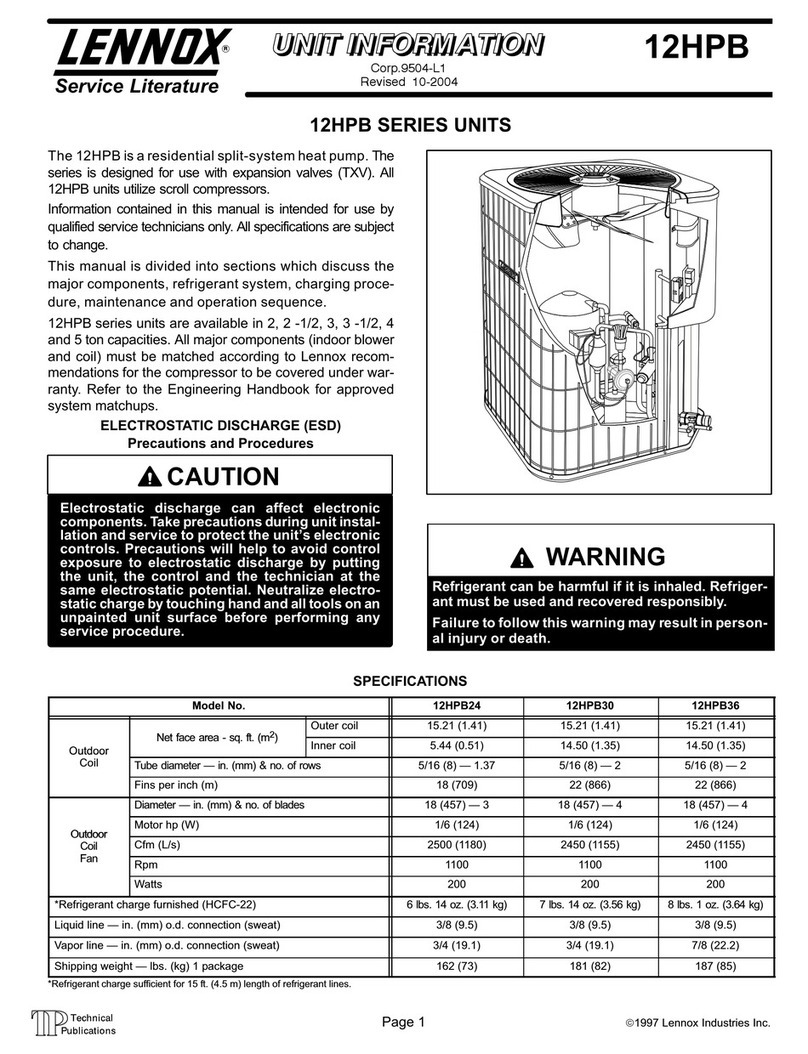Glowworm Envirosorb 8 User manual

1
Installation Instructions
www.glow-worm.co.uk
Air / Water Heat Pump
Envirosorb
Envirosorb 8
Envirosorb 10
Envirosorb 14
30
psi
bar
2040
10
04
13
2
50
58

2
Thank you for installing a new Glow-worm appliance in your home.
Glow-worm appliances are manufactured to the very highest standard so we are pleased to offer
our customers a Comprehensive Guarantee.
This product is guaranteed for 24 months from the date of installation or 30 months from the date
of manufacture, whichever is the shorter, for parts and labour.
The second year of the parts guarantee, from the beginning of the 13th month onwards after
installation or manufacture, is conditional upon the heat pump having been serviced by a
registered installer,
in accordance with the manufacturer’s recommendations. We strongly recommend regular
servicing of your appliance, but where the condition is not met, any chargeable spare parts or
components issued within the applicable guarantee period still benet from a 12 month warranty
from the date of issue by the manufacturer.
We recommend you complete and return as soon as possible your guarantee registration card.
If your guarantee registration card is missing you can obtain a copy or record your registration by
telephoning the Glow-worm Customer Service number 01773 596510.
Guarantee Registration
Customer Service:
01773 828100
Technical Helpline:
01773 828300
General and Sales enquiries:
Tel. 01773 824639
Fax: 01773 820569
Benchmark places responsibilities on both manufacturers and installers. The purpose is to ensure that customers are provided with
the correct equipment for their needs, that it is installed, commissioned and serviced in accordance with the manufacturer’s instruc-
tions by competent persons and that it meets the requirements of the appropriate Building Regulations. The Benchmark Checklist
can be used to demonstrate compliance with Building Regulations and should be provided to the customer for future reference.
Installers are required to carry out installation, commissioning and servicing work in accordance with the Benchmark Code of Prac-
tice which is available from the Heating and Hotwater Industry Council who manage and promote the Scheme.
Visit www.centralheating.co.uk for more information.

3
CONTENTS DESCRIPTION SECTION PAGE
Warnings 4
Important Information 4
Statutory Requirements 5
Safety Regulations and Provisions 6
Safety Devices 6
Servicing, Maintenance and Spare Parts 7
Data Plate 7
Heat pump explained 1 8
Technical data 2 9
Heat pump circuits 3 11
Installation 4 13
Hydraulic Schematic 5 17
Plumbing 6 22
Wiring 7 23
Filling the Heating Circuit 8 27
Conguration 9 28
Settings 10 31
Operational Safety Procedures 11 33
User Information 12 36
Replacement of Parts 13 36
Servicing 14 37
Main Circuit Board 15 38
INTRODUCTION
INSTALLATION
MAINTENANCE
The instructions are an integral part of the appliance and must be handed to the user on
completion of the installation.

4
Metal Parts
This appliance contains metal parts (components) and care
should be taken when handling and cleaning,
with particular regard to edges.
Sealed Components
Under no circumstances must the user interfere with or adjust
sealed parts.
Control of Substances Hazardous to Health
Under Section 6 of The Health and Safety at Work Act
1974, we are required to provide information on substances
hazardous to health.
The adhesives and sealants used in this appliance are cured
and give no known hazard in this state.
The refrigerant used in this appliance is R410a the use of
which is strictly controlled by F Gas regulation EN842/2006.
Manual Handling
With regards to the “Manual Handling Operations, 1992
Regulations”, the appliance exceeds the recommended
weight for a one man lift, refer to Technical Data for more
information.
The handling of the appliance may involve lifting, pushing and
pulling, the use of a sack truck may be required.
The following handling techniques and precautions should be
considered:
- Grip the appliance at its base
- Be physically capable
- Use safety clothing where appropriate, e.g. gloves, safety
footwear.
Ensure safe lifting techniques are used
- Keep back straight.
- Avoid twisting at the waist.
- Avoid upper body/top heavy bending.
- Always grip using the palm of the hand.
- Use designated hand holds if applicable.
- Keep load as close to body as possible.
- Always use assistance if required.
Electrical Supply
The appliance MUST be earthed.
All system components shall be of an approved type and all
wiring to current I.E.E. wiring regulations.
External wiring must be correctly earthed, polarised and in
accordance with the relevant standards.
In GB, this is BS 7671.
In IE, this is the current edition of ETCI rules.
The appliance MUST be connected to a permanent 230V ac,
50Hz supply.
Connection of the whole electrical system of the appliance,
including any heating controls, to the electrical supply MUST
be through one common isolator and must be fuse protected
in accordance with BS7671 - see section 8.
Isolation should be by a double pole switched isolator
adjacent to the appliance. It should be identied as to its use.
Wiring to the appliance must be appropriately sized and
suitable for the application in accordance with BS7671.
This appliance is tested and certicated for safety and
performance. It is, therefore, important that no alteration is
made to the appliance, without permission, in writing, by
Glow-worm.
Any alteration not approved by Glow-worm, could invalidate
the certication, appliance warranty and may also infringe the
current issue of the statutory requirements.
We cannot accept any responsibility for damages arising from
failure to follow the instructions contained in this manual.
All the illustration dimensions in the manual are expressed in
mm.
Retention of the documents
Please supply all of these documents to the appliance user.
The user must keep these documents for future consultation.
The warranty activation application must be sent to
Glow-worm by the Installer or the Authorised heat pump
Technician accompanied by the completed commissioning
report sheet.
Support documents
The commissioning request form (obtainable from G-w Group
Service - tel 01773-828300)
The commissioning template to be completed by the
commissioning engineer)
Warranty sheet to be lled out by the installer or the
Authorised heat pump Technician.
WARNINGS
Metal Parts
This air/water heat pump contains metal parts (components) and care should be taken when handling and
cleaning, with particular regard to edges.
Sealed Components
Under no circumstances must the user interfere with or adjust sealed parts.
Refrigerants
The air/water heat pump unit contains pressurised refrigerants, only qualied persons should work on this
system and under no circumstances should these refrigerants be discharged to atmosphere.
Important Information

5
CE marking
The CE marking shows that the appliances described in this
manual are in compliance with the following directives:
Directive relating to electromagnetic compatibility – (Council
of the European Communities directive 89/336/EEC).
Directive relating to electrical equipment designed for
use within certain voltage limits (Council of the European
Communities directive 73/23/EEC).
Directive relating to pressure equipment – (Council of the
European Communities directive -97/23/EEC).
Directive relating to machinery (Council of the European
Communities directive 89/392/EEC).
Under CE directive these appliances are approved and tested
to EN14511 parts 1 to 4
IMPORTANT
Where no British Standards exists, materials and equipment
should be t for their purpose and of suitable quality and
workmanship.
The installation of this appliance must be carried out by a
competent person in accordance the rules in force in the
countries of destination.
Manufacturer’s instructions must not be taken as overriding
statutory requirements.
Safety instructions
Any work carried out within the appliance must be conducted
by a certied professional in accordance with current
regulations (handling refrigerants, live electrical work etc.) or
the Glow-worm Post-Sales Service.
WARNING There is the risk of electric shock and damage to
the equipment if it is not installed correctly.
WARNING The refrigerant circuit may only be worked by a
qualied specialist.
When assembling the connectors, ensure that the watertight
joints are positioned correctly in order to avoid any leaks.
Do not, under any circumstances, disable any of the safety
devices and do not attempt to manhandle these devices or
you will run the risk of causing a malfunction.
The following safety instructions must be adhered to when
the appliance is being serviced or when any parts are being
replaced.
Shut the appliance down.
Isolate the appliance from the electricity supply:
- either by unplugging the appliance,
- or via the system circuit breaker.
Close the isolating valve on the heating circuit.
Drain the system down if you need to replace any hydraulic
parts.
Allow the appliance to cool before carrying out any
maintenance works.
Ensure that the electrical parts are protected from water when
handling.
Only use new waterproof gaskets and o-rings.
Following completion of the repair works, check the
replacement parts are functioning correctly.
R410 A Refrigerant
Only use R410 A Refrigerant.
The tools used to ll the system, gauge the pressure and
emptying the refrigerant for recycling must be compatible with
and used exclusively for R410 A refrigerant.
In the case of a refrigerant leak requiring additional refrigerant,
this must be carried out in the liquid phase after rst repairing
the leak and must not exceed the amount shown on the
appliance data plate.
If the full refrigerant charge has been lost, repair the leak then
evacuate. Evacuate the circuit with a maximum pressure of 30
mbar (static pressure) before recharging with fresh refrigerant
in the liquid phase using a refrigeration quality vacuum pump.
Do not attempt any solder work on the circuit without having
removed all of the refrigerant rst.
WARNING Do not smoke or light any naked ames during
the system removal and rell operations. The gases emitted
through combustion of the refrigerant are toxic.
Standards
On installing and commissioning the appliance you must
adhere to the technical rules, standards and provisions in
effect at the time.
Standardisation, regulations and
certication
Heat pumps are regulated by the standards on performance
measurement, suitability of use and electrical safety.
Reminder of existing regulatory acts
EC regulation No. 20372000 from the 29th of June 2000
This European regulation repeals regulation No. 3093/94
and presents the elimination schedules of CFC and HCFC.
It also deals with the collection of refrigerants, system leaks,
particularly systems containing more than 3 kg of CFC or
HCFC, as well as the minimum level of qualication required
by the technicians.
EC regulation No. 0842/2006 from the 17th of May 2006
regarding the containment, use, collection and disposal of the
uorinated greenhouse gases, the labelling and elimination
of the products and equipment containing these gases, the
restriction of use and banning of certain products from the
market, as well as the training and certication of personnel
and companies operating in the activities targeted by this
regulation: refrigeration, air-conditioning, heat pumps and re
protection systems containing greenhouse gases.
Statutory Requirements

6
Safety Devices
Electrical Supply Failure
The appliance will not work without an electrical supply.
Normal operation of the appliance should resume when the
electrical supply is restored.
Reset any external controls, to resume normal operation of
the central heating.
If the appliance does not resume normal operation check all
safety devices are re-set and no fault codes are shown. If the
heat pump does not resume normal operation after this call
your Installation/Servicing company or Glow-worm service.
Overheating Safety
The appliance software is designed to recognise the potential
for an overheat lockout and will shutdown before this
happens.
If the appliance fails to resume normal operation and
all external controls are calling for heat, then call your
Installation/Servicing company or Glow-worm service.
organisation using the telephone number on the inside front
cover of this booklet.
Condensate Drain Blockage
The heat pump will in normal operation create condensate
water which is collected in the drip tray at the bottom of the
unit and drains out of the appropriate drain connection.
In severe temperatures this condensate can freeze in the pipe
causing a build up of ice in the heat pump. If this should occur
warming the drain pipe with a warm cloth or rag will help clear
the blockage.
In areas where freezing of the drain is a regular possibility
propriety drain heater elements can be purchased and tted
by your heat pump installer.

7
Data Plate
Servicing and Maintenance
To ensure the continued efcient and safe operation of the
appliance it is recommended that it is checked and serviced
as necessary at regular intervals. The frequency of servicing
will depend upon the particular installation conditions and
usage.
Servicing/maintenance should be carried out by a competent
person in accordance with the rules in force in the countries of
destination.
To obtain service, please call your installer or Glow-worm’s
own service organisation using the telephone number on the
inside front cover of this literature.
Replacement Parts
Remember, when replacing a part on this appliance, use only
spare parts that you can be assured conform to the safety and
performance specication that we require.
Do not use reconditioned or copy parts that have not been
clearly authorised by Glow-worm.
If a part is required contact your Glow-worm supplier or Glow-
worm’s own service organisation.
Please quote the name and serial number of the appliance,
this information will be on the data plate on the side of the
appliance.
If in doubt seek advice from Glow-worm’s own service
organisation using the telephone number on the inside front
cover of this booklet.
Servicing, Maintenance and Spare Parts
30
psi
bar
20 40
10
04
1
3
2
50
58
DATA PLATE
15201

8
1 Heat pump operation
1.1 How a heat pump works
1
2
6
4 5
3
A heat pump is a device for transferring heat from one
environment to another. It takes (renewable) heat energy from
the ambient air, concentrates the energy and transfers it to the
heating water.
Even when the ambient air is below freezing point there is still
ample heat energy available for the heat pump to transfer.
In the diagram above the refrigerant gas is drawn into the
compressor (4) and compressed to a high temperature, high
pressure gas, it then passes via the change over valve (1) to
the refrigerant to water heat exchanger (6) where it gives up
it’s heat to the heating water circuit. In doing so the refrigerant
is changed from a high pressure gas into a high pressure
liquid. The liquid refrigerant then enters the expansion device
(5) where it passes through a small orice in the device
causing it’s pressure (and temperature) to fall signicantly.
As a result of this temperature loss the refrigerant absorbs
heat from the surrounding ambient air as it continues to
pass through the air to refrigerant heat exchanger (2). The
refrigerant is then drawn back to the compressor and the
cycle continues once more.
Occasionally, particularly in low ambient operating conditions
there can be a build up of frost on the external heat
exchanger.
This causes a fall off in efciency and has to be removed. This
is achieved by the control operating the change over valve(1)
causing it to move to the defrost position.
Which then causes the high temperature refrigerant from the
compressor to ow directly to the outdoor heat exchanger
instead of a plate heat exchanger melting the frost build up.
The refrigerant continues in this reverse direction through the
expansion device and ther plate heat exchanger and back to
the compressor via the changer over valve.
The process continues until all of the frost has been removed
at whcih time the control re-sets the change-over valve to the
heating position once more.
1.2 Operational Range
A
B
10°
20°
25°
55°
30°
40°
50°
60°
-15° -10° -5° 0° 5° 10° 15° 20° 25° 30°
1
Key
1 Max. temperature
A Water temperature (Output)
B Air temperature (External)
Your Envirosorb unit will only operate within the shaded
operational range
15204
15206
Diagram 1.1
Diagram 1.2
Key
1 Heating/cooling changeover valve
2 Air to refrigerant heat exchanger (evaporator in
heating mode)
3 Fan
4 Compressor
5 Expansion device
6 Refrigerant to water heat exchanger
(condenser in heating mode)

9
2 Technical Data
2.1 Single phase heat pump
Description Unit Envirosorb 8 Envirosorb 10 Envirosorb 14
Performance with underfloor cooling
Performance with underfloor heating
(Water flow 35°C, return 30°C, wet temperature: 6°C)
Heating output kW 8.00 9.30 13.74
Power input kW 2.33 2.70 3.51
Coefficient of performance COP 3.43 3.44 3.91
(Water flow 18°C, return 23°C, outside dry temperature: 35°C)
Cooling output kW 7.68 9.53 16.35
Power input kW 2.79 3.35 4.90
Energy Efficiency Rating EER 2.75 2.84 3.34
Noise level and air flow
Sound power level dbA 68 68 70
Sound pressure level dbA 55 55 57
Airflow rates m3/h 3500 3500 5200
Heating circuit
Max. supply pressure bar 3 3 3
Minimum static pressure bar 1 1 1
Nominal water flow rate in heating mode l/h 1275 1535 2430
Minimum water flow rate l/h 844 1181 1388
Refrigerant circuit
Type of refrigerant R 410 A
Quantity of refrigerant kg 3.2 2.8 4.6
Type of compressor Scroll
Electrical
Supply voltage/frequency V/Hz 1/N/PE 230V 50Hz
Maximum compressor power in heating mode kW 3.36 4.33 6.10
Maximum compressor current in heating mode A 13.88 17.88 25.20
Start-up current (without soft start) A 40 48 65
Dimensions
Height mm 900 900 1300
Width mm 1100 1100 1100
Depth mm 352 352 352
Ø Heating circuit connectors Inches 1" 1" 1" 1/4
Dimensions
Nett total weight kg 101 103 151
Gross total weight kg 112 114 162
NOTE: Fluorinated greenhouse gases as identied in the
Kyoto protocol, are contained within a fully sealed system.
15299

10
2 Technical data - Dimensions
30
psi
bar
20 40
10
04
13
2
50
58
384
360
606
245 245
900
26
352
96
1100
108
240
15212
30
psi
bar
2040
10
04
13
2
50
58
384
360
606
245 245
1300
26
352
96
1100
108
240
15213
Envirosorb 8 & 10
Envirosorb 14
Diagram 2.1
IMPORTANT: Upper connection is heating return and lower
connection is heating ow - always ensure connections are correct

11
3 Refrigerant Systems
Envirsorb 8 & 10 - refrigeration circuit (heating mode)
Key
1 Exterior protection grille
2 (NTC 1) exterior ambient sensor
3 Heat pump casing
4 (NTC 2) air/refrigerant thermistor
5 (V4V) 4-way valve
6 Expansion vessel (hydraulic system)
7 Manual water circuit air vent valve
8 Fan
9 Refrigerant circuit high pressure Schrader access
connector
10 Water circuit pressure gauge
11 Air/refrigerant heat exchanger
12 Refrigerant circuit low pressure Schrader access
connector
13 High pressure refrigerant safety pressure switch
14 Branch connection not used
15 High-pressure refrigerant circuit sensor
16 (K4) high temperature safety thermostat
17 (R2) drip tray anti-freeze heater element
18 Scroll Compressor
19 Refrigerant expansion vessel
20 Refrigerant/water plate exchanger
21 Water circuit circulation pump
22 (NTC 5) water return sensor
23 (R1) plate exchanger / water anti-freeze heater element
24 (Db) water ow detector
25 Hydraulic circuit pressure relief valve (factory set at 3 bar)
26 (NTC 4) water ow temperature sensor
28 Bafe plate expansion device
29 Bi-directional lter/dryer
30 (NTC 3) plate exchanger anti-freeze heater temperature
sensor
A Air inlet
B Air outlet
C Heating circuit return
D Heating circuit ow
3029
28
26
25
24
23
22212019
18
17
1615
14
13
12
11
109
8
7
65
4
3
2
1
15208
Diagram 3.1

12
3 Refrigerant Systems
33
33
32
31
30
29
28
27
26
25
24
232221
20
19
18
17
16
1514
13
121110
8
8
7
65
4
3
2
1
Envirosorb 14 - refrigerant circuit (heating mode)
Key
1 Exterior protection grille
2 (NTC 1) Exterior ambient sensor
3 Heat pump casing
4 (NTC 2) air/refrigerant thermistor
5 (V4V) 4-way valve
6 Expansion vessel (hydraulic system)
7 Manual water circuit air vent valve
8 Fans
10 Heat pump Schrader connector
11 Refrigerant circuit low pressure Schrader access
connector
12 Water circuit pressure gauge
13 Heat pump safety pressure switch
14 High-pressure refrigerant circuit sensor
15 (K4) overheating safety thermostat
16 Scroll Compressor
17 Expansion sensor in cooling mode
18 Expansion sensor in heating mode
19 Air/refrigerant heat exchanger
20 (R2) drip tray anti-freeze heater element
21 Refrigerant/water plate exchanger
22 Water circuit circulation pump
23 (NTC 5) water return sensor
24 (R1) plate exchanger / water anti-freeze heater element
25 (Db) water ow detector
26 Hydraulic circuit pressure relief valve (factory set at 3 bar)
27 (NTC 4) water ow temperature sensor
28 (NTC 3) plate exchanger anti-freeze heater temperature
sensor
29 Refrigerant expansion vessel
30 Thermostatic expansion valve in heating mode
31 Bi-directional lter/dryer
32 Thermostatic expansion valve in reverse mode
A Air suction
B Air outlet
C Heating return circuit
D Heating circuit ow
15209
Diagram 3.2

13
4 Installation
4.1 Pre-installation recommendations
All heat pumps operate at their most efcient when connected
to low temperature radiators or underoor heating systems.
If any scheme other than those shown in this manual is
proposed for use with an Enviorosorb unit please contact our
technical helpline for assistance.
The layout of the piping must be planned in such as way as
to avoid forming air pockets and to facilitate the bleeding of
air from the system. All the plumbing high points and radiators
must be tted with a air bleeding valves.
If thermostatically controlled valves are used, it is advisable
that you do not t them on all the radiators and never in the
room in which the ambient thermostat is installed. Consider
tting a system by-pass valve to ensure minimum ow
through the heat pump.
Please ensure that the heating circuit water ow corresponds
to the nominal volume ow of the appliance (see chapter 1
“Technical data”).
As well as the standard pipework and heat emitters, the
following hydraulic parts are required as a minimum to be
tted to all installations. See section 5 for typical heating
schematics:-
A lling station, refer to section 8, including a back-ow stop
valve on the cold water inlet allowing you to ll and bleed the
circuit.
Isolating valves between the heat pump and the heating
circuit, either side of any pumps, lters or other maintainable
parts.
A ow regulator valve to balance the system ow and a
by-pass regulator to ensure ow through the heat pump is
maintained should all thermostatic valves close.
An additional lter, secondary boost pump, buffer vessel and
expansion tank (as necessary).
An air separator.
Insulation and protection for the external pipework.
Suitable and sufcient glycol mix to ensure frost protection in
low temperatures.
4.2 Appliance pack contents
WARNING The batteries must be placed into the heat pump
control panel.
If they are not tted or they are low on power, this may cause
communication errors and technical faults in the appliance.
Batteries contain substances that are harmful to the
environment. As such they must not be thrown out with
the general waste and should be disposed of properly in
accordance with current waste regulations.
1
2
345
6
15215
Diagram 4.1
30
psi
bar
2040
10
04
1 3
2
50
58
Envirosorb 8 & 10
Key
1 Heat pump
2 Instructions and warranty documents pack
3 Filter
4 Drain plug
5 Drainage elbow
6 Batteries for controller

14
30
psi
bar
20 40
10
0 4
1 3
2
50
58
4 Installation
30
psi
bar
20 40
10
04
13
2
50
58
4.3 Unpacking the appliance
Remove the packaging carefully ensuring that you don’t
damage the appliance. Dispose of the packaging responsibly.
Remove the fastening screw (2) from the pallet (3) in the front
and the rear of the appliance, see diagram 4.3.
IMPORTANT: With regards to the Manual Handling
Operations, 1992 Regulations, the following lift operation
exceeds the recommended weight for a one man lift.
15217
1
2
34 5
6
15216
Diagram 4.2
Diagram 4.3
Envirosorb 14
Key
1 Heat pump
2 Instructions and warranty documents pack
3 Filter
4 Drain plug
5 Drainage elbow
6 Batteries for control panel

15
4 Installation
4.4 Transporting the appliance
WARNING: Refer to diagram 4.4, do not lean the appliance
more than 45° during transportation as this may damage the
refrigeration circuit which could lead to a complete system
failure.
4.5 Moving appliance into place
IMPORTANT: With regards to the Manual Handling
Operations, 1992 Regulations, the following lift operation
exceeds the recommended weight for a one man lift.
Install the heat pump on a raised concrete base (refer to
section 4.8).
The appliance must be securely xed to the ground using
appropriately sized xings.
NOTE: Due to the varied site conditions we do not supply
xings and advise that the installer should supply those which
are suitable.
Mark the xing points, drill holes then x the heat pump in
place.
4.6 Using the anti-vibration mounts
If the appliance is installed in a position where transmitted
noise and vibration may be an issue, the heat pump should
be mounted on anti-vibration mounts which are available as a
Glow-worm accessory.
You can also use these blocks on at solid ground or a
concrete base in order to raise the appliance and facilitate
drainage.
15218
Diagram 4.4
30
psi
bar
20 40
10
0 4
13
2
50
58

16
4.8 Correct support
Install the heat pump on a raised concrete base or well
drained solid support in order to limit the risk of ooding, see
diagram 4.6.
A slight incline between Aand B(max 2o) will assist removal
of condensate.
4 Installation
4.7 Positioning the heat pump
This heat pump is designed for external use only.
Do not install it in the proximity of a heat source or ammable
materials.
Check that the heat pump fan is not installed adjacent to a
window or other opening into the property.
Check that the noises and vibrations are not transmitted to
surrounding properties.
Do not expose the heat pump to a corrosive or dusty
environments (close to a dirt path for example).
Do not install close to trees and shrubs that may lose their
leaves in autumn.
Do not place it close to foul air extraction fans or boiler
outlets.
Do not position in the face of the prevailing wind or opposite
other heat pump air outlets.
Adhere to the minimum clearence dimensions in order to
obtain the correct air ow and to facilitate maintenance works,
see diagram 4.5.
Ensure that there is sufcient space available to t the heating
circuit plumbing and insulation.
30
psi
bar
20 40
10
0 4
1 3
2
50
58
500
min.
500
min.
1500 min.
1500 min.
15210
15211
Diagram 4.5 Diagram 4.6
A
B
100 min.
30
psi
bar
20 40
10
04
1 3
2
50
58
HEAT PUMP
CONCRETE BASE
Fall to drain required up to a max of 2o

17
5 Hydraulic Schematics
5.1 A single heating zone underoor
heating using the Envirosorb controller
Heating ow temperature < 50°C (optimum <35C).
Electrical back-up heater with single heat setting controlled
via Envirosorb control.
Water temperature controlled via sensor checks on the ow &
return temperature to the heat pump.
Electrical connections
L‘
N
L
N
L1
L2
L3
C0
CI
17
16
15
14
5
4
3
2
1
15428
Diagram 5.1
System A schematic
Key
1 Heat pump
2 Underoor heating
3 Return
4 Flow
5 Control thermostat
6 Expansion chamber (option)
7 Buffer vessel
8 Electrical heater
15256
Diagram 5.2
5
2
6
1
3
4
7
8
▲ ▲ ▲ ▼ ▲ ▼ ▲ ▲ ▲ ▼ ▲ ▼ ▲ ▲ ▼ ▼
This then gives access to the cong menu where the following
settings can be altered as required.
1
down
1
up
3
up
1
down
3
up
1
down
1
up
1
down
2
up
2
down
With control switched off enter access code as follows:
NOTE: For heating schewmes other than those shown
in this manual contact Glow-worm Technical Support for
guidance

18
5 Hydraulic Schematics
CONFIG menu setting table
Parameter
No.
Menu Name System
setting
Range Factory
setting
Notes
System Conguration
02 DHW control by HP sensor (accessory) 0 0/1 0 If DHW sensor tted this must be set to 1
06 Legionella Protection (only active if
parameter 2 set to 1)
0 0/1 0 Allows activation of DHW legionella
protection using DHW sensor accessory
11 Auto adaptive regulation selection 0 0/1 0 Set to 1 to allow manual differential setting
(Parameter 31)
12 Back-up heating required during de-frost 0 0/1 0 Set to 1 for heater to support HP during
de-frost
13 Underoor cooling sensors tted
(accessory)
0 0/1 0 Set to 1 if control used as accessory tted
14 Control used as a thermostat 0 0/1 0 Set to 1 if control used as a thermostat
15 Heating curve setting (only if control is
thermostat)
0 0/1 0 Set to adjust fan curve
(Parameter 41 and 42)
16 Underoor cooling sensor (only active if
parameter 13 set to 1)
0 0/1 0 If Envirosorb control of underoor sensor
required this must be set to 1
17 Dew point sensor sensor (only active if
parameter 13 set to 1)
0 0/1 0 If Envirosorb control of dew point sensor
required this must be set to 1
18 DHW sensor (only active if parameter 2
set to 1)
0 0/1 0 If Envirosorb control of DHW sensor
required this must be set to 1
Parameter Setting
24 Water temperature setting (cooling) +18oC -10 to 20 +18oCSet cooling output ow temperature as
required
26 Water temperature setting (heating) +35oC 23 to 55 +35oCSet heating output ow temperature as
required
30 Back-up heater low temperature
operation
+5oC -9 to 20 +5oC Low temperature setting which
automatically triggers back-up heating
31 Heat pump return temperature hysteresis
(differential)
1 1 - 3 1 HP switches off when ow temp. (para.
26) is reached and re-starts when
differential below return temperature
recorded when HP stops is reached
39 Back-up heater operating on temperature 5 0 - 15 5 Set differential temperature at which
boost heater supports HP i.e. temperature
differential between ow temperature and
set point which triggers back-up
40 Back-up heating switch off temperature 0 0 - 15 0 Sets differential below set point
temperature (parameter 26) at which the
heater switches off
41 Heating curve trough 0 0.5 to
4.3
0 If para. 15 set to 1, allows heating trough
to be adjusted when outside temperature
is 20oC (see chart)
42 Heating curve slope 1 0 - 15k 1 If para. 15 set to 1, allows heating slope to
be selected as required (see chart)
51 Immersion heater shut-off temperature 55 45-60 55 If para. 2 set to 1, allows adjustment of set
point temperature for immersion heater

19
Dip switch setting
If an external/secondary control is used to control the
Envirosorb unit (connected to terminals7 & 8), switch 1 must
be set to on. Switch 2 should be off at all times.
ON
OFF
SW1 switch
on main PCB
15252
Diagram 5.3
5.2 Operation
When the heat pump stops by the ow temperature setting
(parameter 26) the software registers the return temperature.
The setting of parameter 31 dictates the differential
temperature for the compressor re-start
e.g. Heating mode - parameter 26 set at 35ºC and parameter
31 set at 2.
• Compressor stops at ow temperature of 35ºC with say
30ºC.
• When return temperature drops to 28ºC (30ºC – 2ºC) the
compressor starts again.
• Regardless the compressor stops for a minimum of 3
minutes due to in-built delay timer.
5 Hydraulic Schematics

20
5 Hydraulic Schematics
5.3 A single heating zone radiator heating
using the Envirosorb controller
Heating ow temperature < 50°C (optimum <35C).
Electrical back-up heater with single heat setting controlled
via Envirosorb control.
Water temperature controlled via sensor checks on the ow &
return temperature to the heat pump.
15422
Diagram 5.4
System B schematic
5
1
3
4
72
6
8
9
Key
1 Heat pump
2 Low temperature radiator
3 Return
4 Flow
5 Control thermostat
6 Expansion chamber (option)
7 Buffer vessel
8 Electrical heater
9 By-pass valve
▲ ▲ ▲ ▼ ▲ ▼ ▲ ▲ ▲ ▼ ▲ ▼ ▲ ▲ ▼ ▼
This then gives access to the cong menu where the following
settings can be altered as required, see table over.
NOTE: For heating schemes other than those shown in this
manual contact Glow-worm Technical Support for guidance.
5.4 Operation
When the heat pump stops by the ow temperature setting
(parameter 26) the software registers the return temperature.
The setting of parameter 31 dictates the differential
temperature for the compressor re-start
e.g. Heating mode - parameter 26 set at 35ºC and parameter
31 set at 2.
• Compressor stops at ow temperature of 35ºC with say
30ºC.
• When return temperature drops to 28ºC (30ºC – 2ºC) the
compressor starts again.
• Regardless the compressor stops for a minimum of 3
minutes due to in-built delay timer.
1
down
1
up
3
up
1
down
3
up
1
down
1
up
1
down
2
up
2
down
With control switched off enter access code as follows:
Electrical connections Diagram 5.5
L‘
N
L
N
L1
L2
L3
C0
CI
17
16
15
14
5
4
3
2
1
15256
Electrical connections
Other manuals for Envirosorb 8
1
This manual suits for next models
2
Table of contents
Other Glowworm Heat Pump manuals


